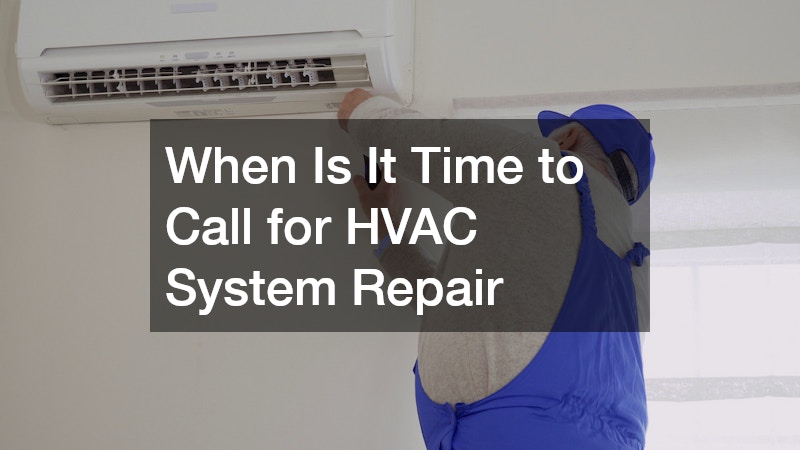
When Is It Time to Call for HVAC System Repair
Understanding when your HVAC system needs repair is crucial for maintaining your home’s comfort and efficiency. This article aims to guide you through identifying the right time to seek professional assistance for your HVAC system. With proactive care and attention, homeowners can prolong the lifespan of their HVAC systems and maintain optimal indoor air quality.
Unusual Noises and Their Meanings
Squeaking, banging, or humming noises can be indicators of HVAC issues that require attention. Squeaks might suggest that a belt within the system is slipping, which, if left unchecked, could lead to further complications.
Meanwhile, banging sounds can indicate a loose part within the system, which necessitates immediate investigation to prevent damage.
Understanding the different noises your HVAC system makes can significantly impact its longevity and performance. A humming noise, for instance, could signify electrical problems that, if ignored, may escalate into costly repairs. Regularly attending to these sounds helps in maintaining energy efficiency and preventing unexpected breakdowns.
Inconsistent Heating or Cooling
HVAC systems are designed to maintain a consistent temperature throughout your home, providing comfort across seasons. If you notice cold spots during the winter or hot spots in summer, your system may require professional evaluation. Inconsistent temperatures can stem from issues like faulty thermostats or blocked vents, an HVAC system repair may be needed by an HVAC technician.
Temperature fluctuations within a home can increase energy consumption as the system works harder to balance the climate. It’s essential to check for potential causes such as clogged filters or misaligned thermostats, which are common culprits. Regularly maintaining these components can safeguard against such inefficiencies, preserving both comfort and budget.
Increasing Energy Bills
An unexpected rise in energy bills can be one of the clearest indicators of a malfunctioning HVAC system. When an HVAC unit isn’t operating efficiently, it consumes more electricity to achieve the desired temperature, inadvertently boosting monthly bills. Awareness of your system’s efficiency can help in identifying these issues early on, thereby saving costs over time.
Homeowners can take simple measures, such as noting monthly energy consumption trends, to spot inefficiencies. Increased energy use can often be resolved by routine maintenance tasks like replacing air filters and tuning the system. Such proactive steps not only optimize system performance but also contribute to reduced environmental impact by lowering energy consumption.
Thermostat Settings and Functions
Before reaching out for professional help, homeowners can perform simple checks on their thermostat settings, which often reveals root causes of heating or cooling issues. Ensure that the thermostat is correctly set to either heat or cool and verify that it’s displaying the accurate current temperature. Misprogrammed thermostats can easily mimic system faults when, in reality, the solution is straightforward.
Regularly updating your thermostat’s software and ensuring its battery life can further prevent issues. Smart thermostats particularly require frequent monitoring and possible recalibration to function optimally. These steps not only resolve minor inconveniences but also contribute significantly to the efficient operation of your HVAC system.
Filter Maintenance and Replacement
Clean air filters are essential for the optimal functioning of an HVAC system, making filter maintenance a non-negotiable task for any homeowner. Filters should ideally be replaced every 1-3 months, depending on the filter type and environmental factors such as pet presence. Regular replacements ensure that air flows freely through the system, which prevents the system from overworking and potentially failing.
Moreover, dirty filters can recirculate dust and allergens throughout your home, degrading indoor air quality. Simple visual inspections of the filter can provide insight into the system’s state, as significant debris accumulation can be visibly assessed. A quick swap of an old filter for a clean replacement can remarkably enhance system performance and energy efficiency.
Inspecting Vents and Airflow
Vent inspection is another preliminary troubleshooting step homeowners can undertake before calling in professional services. Blocked supply or return vents can significantly disrupt airflow, leading to uneven heating and cooling or system strain. Checking for obvious obstructions, like furniture or dust deposits, may reveal simple fixes to optimize airflow.
Regular vent cleaning prevents the accumulation of dust and debris, which can otherwise impede air circulation, affecting overall system effectiveness. It ensures that both heating and cooling cycles run smoothly, thereby maintaining home comfort consistently. Such proactive management also supports both air quality indoors and system longevity.
Evaluating Repair vs. Replacement
As HVAC systems age, the debate on whether to repair or replace them becomes increasingly pertinent. A system frequently needing repairs signals potential end-of-life concerns, where replacement becomes more cost-effective. Professional assessments provide clarity by evaluating factors such as system age, component availability, and future repair costs.
A well-maintained HVAC system is essential for home comfort and efficiency. By knowing the signs of trouble, actions to take on your own, and when to call for professional help, you can ensure your HVAC system continues to serve you well. Through proactive care, timely replacements, and professional maintenance, homeowners can sustain ideal indoor climates year-round while optimizing energy use.
